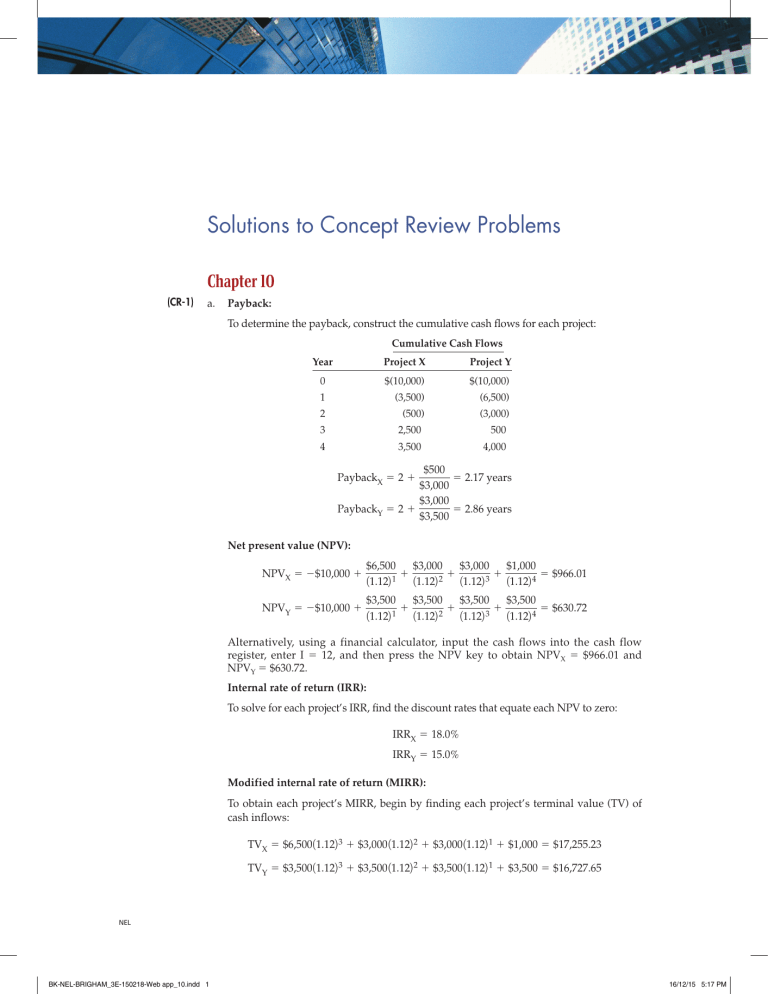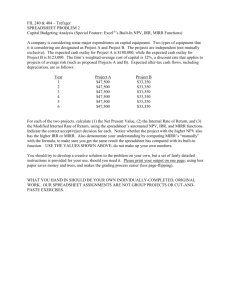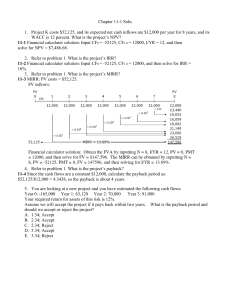
Solutions to Concept Review Problems Chapter 10 (CR-1) a. Payback: To determine the payback, construct the cumulative cash flows for each project: Cumulative Cash Flows Year Project X Project Y 0 $(10,000) $(10,000) 1 (3,500) (6,500) (500) (3,000) 2 3 2,500 500 4 3,500 4,000 $500 5 2.17 years $3,000 $3,000 PaybackY 5 2 1 5 2.86 years $3,500 PaybackX 5 2 1 Net present value (NPV): NPVX 5 2$10,000 1 NPVY 5 2$10,000 1 $6,500 $3,000 $3,000 $1,000 1 1 1 5 $966.01 11.122 1 11.122 2 11.122 3 11.122 4 $3,500 $3,500 $3,500 $3,500 1 1 1 5 $630.72 1 2 3 11.122 11.122 11.122 11.122 4 Alternatively, using a financial calculator, input the cash flows into the cash flow register, enter I 5 12, and then press the NPV key to obtain NPVX 5 $966.01 and NPVY 5 $630.72. Internal rate of return (IRR): To solve for each project’s IRR, find the discount rates that equate each NPV to zero: IRRX 5 18.0% IRRY 5 15.0% Modified internal rate of return (MIRR): To obtain each project’s MIRR, begin by finding each project’s terminal value (TV) of cash inflows: TVX 5 $6,500 11.122 3 1 $3,000 11.122 2 1 $3,000 11.122 1 1 $1,000 5 $17,255.23 TVY 5 $3,500 11.122 3 1 $3,500 11.122 2 1 $3,500 11.122 1 1 $3,500 5 $16,727.65 NEL BK-NEL-BRIGHAM_3E-150218-Web app_10.indd 1 16/12/15 5:17 PM Now, each project’s MIRR is the discount rate that equates the PV of the TV to each project’s cost, $10,000: MIRRX 5 14.61% MIRRY 5 13.73% b. The following table summarizes the project rankings by each method: Project That Ranks Higher Payback X NPV X IRR X MIRR X Note that all methods rank Project X over Project Y. In addition, both projects are acceptable under the NPV, IRR, and MIRR criteria. Thus, both projects should be accepted if they are independent. c.In this case, we would choose the project with the higher NPV at r 5 12%, or Project X. d.To determine the effects of changing the cost of capital, plot the NPV profiles of each project. The crossover rate occurs at about 6% to 7% (6.2%). See the graph below. If the firm’s cost of capital is less than 6.2%, a conflict exists because NPVY . NPVX, but IRRX . IRRY. Therefore, if r were 5%, a conflict would exist. Note, however, that when r 5 5.0%, MIRRX 5 10.64% and MIRRY 5 10.83%; hence, the modified IRR ranks the projects correctly, even if r is to the left of the crossover point. NPV Profiles for Project X and Y NPV ($) NPVY 4,000 3,000 Crossover Rate = 6.2% 2,000 NPVX 1,000 0 5 10 15 IRRY 20 IRRX Cost of Capital (%) 1,000 NPVX NPVY $3,500 $4,000 4 2,545 2,705 8 1,707 1,592 12 966 631 Cost of Capital 0% NEL BK-NEL-BRIGHAM_3E-150218-Web app_10.indd 2 16/12/15 5:17 PM 5 10 15 IRRY 20 IRRX Cost of Capital (%) 1,000 NPVX NPVY $3,500 $4,000 4 2,545 2,705 8 1,707 1,592 12 966 631 16 307 (206) 18 5 (585) Cost of Capital 0% e.The basic cause of the conflict is differing reinvestment rate assumptions between NPV and IRR. NPV assumes that cash flows can be reinvested at the cost of capital, while IRR assumes reinvestment at the (generally) higher IRR. The high reinvestment rate assumption under IRR makes early cash flows especially valuable, and hence short-term projects look better under IRR. NEL BK-NEL-BRIGHAM_3E-150218-Web app_10.indd 3 16/12/15 5:17 PM






